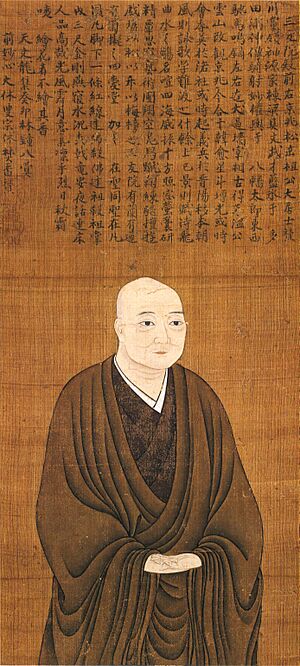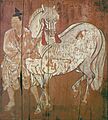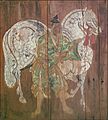Kanō Motonobu facts for kids
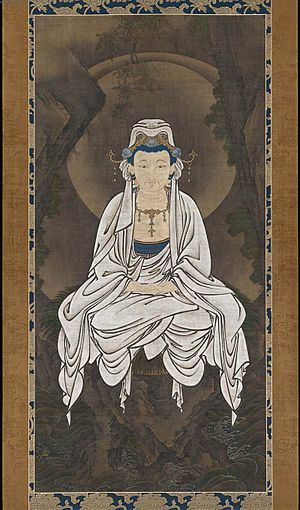
Kanō Motonobu (born August 28, 1476 – died November 5, 1559) was a famous Japanese painter and calligrapher. He was a very important member of the Kanō school of painting. Thanks to his smart leadership and hard work, he helped the Kanō school become one of the most important art schools in Japan. This school trained many painters during the Edo period (1603–1868), which was a long time of peace and growth in Japan. After he died, people called him Kohōgen.
Contents
Kanō Family History
The Kanō family came from a group of warriors in the Kanō district. This area is now known as Shizuoka Prefecture in Japan. The first known artist in the family was Kanō Kagenobu. He was a loyal follower of the Imagawa family. It is said that he painted a picture of Mount Fuji for the shōgun (a military ruler) Ashikaga Yoshinori in 1432. The Kanō family became very powerful in the art world. They were important from the end of the Muromachi period (1336–1573) until the end of the Edo period.
Kanō Motonobu's father, Kanō Masanobu, started the Kanō school. Masanobu became the official painter for the Ashikaga shogunate (the government led by the shōgun) in 1481. He was a professional artist who used the Kanga style. This style was based on Chinese ink painting. His family members and students continued his art style, forming the Kanō school.
Motonobu's Career as an Artist
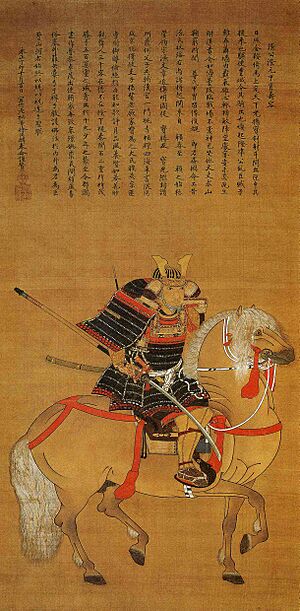
Kanō Motonobu started his art journey at a young age. When he was only 10, he worked for General Ashikaga Yoshihisa. He also served another shōgun, Ashikaga Yoshizumi.
As the son of the Kanō School's founder, Motonobu learned Kanga (Chinese-style ink painting) from his father. He showed great talent early on. By the age of nine, he was already getting important art jobs. Powerful people hired him, including the shōgun's government and rich merchants in Kyoto. He also worked for important temples and shrines.
One of his first big jobs was in 1515. He painted special wooden plaques called e-ma for the Itsukushima Shinto shrine. These plaques showed the Thirty-six Poetry Immortals. A group of merchants from Sakai hired him for this project. These artworks can still be seen in Hiroshima Prefecture today.
By the 1530s, Motonobu was a busy man. He married the daughter of Tosa Mitsunobu, who led the rival Tosa school of painting. He had three sons: Shōei, Yusetsu, and Joshin. Motonobu led a small Kanō art workshop in northern Kyoto. This workshop had about ten people. It included Motonobu, his three sons, his younger brother Yukinobu, and other assistants.
Motonobu was the main leader of these art projects. He handled everything from getting the jobs to organizing the painting work. He was also very good at selling his art. Motonobu was known for being charming and smart. He was also a strong businessman. He often asked the shōgun for many different art jobs. He worked with his merchant friend, Hasuike Hideaki, to get these commissions.
Motonobu lived through a difficult time in Japan called the Warring States period. But he was still able to get support from powerful people. These included the shōgun, the imperial court, and wealthy townspeople.
Even with all his business work, Motonobu spent a lot of time painting. As the head of the Kanō school, he painted the most important parts of a building. Then, he gave other parts to his sons and assistants based on their skill. These jobs could be painting their own rooms or preparing materials. They might grind colors, prepare paper, or fill in large areas of color. Motonobu's business skills helped the workshop grow. He trained his family members and other students. They learned by watching him work and by copying his style.
Motonobu created many different types of artworks. He painted portraits, like "Iio Munegi" (now in the Museum of Fine Arts, Boston). He also painted votive tablets, like the "Kamo Shimba Zukaku" (a horse painting) for the Kamo Shrine. Many of his works still exist today.
Motonobu's Painting Style
Motonobu was famous for his Chinese-style ink paintings, called suiboku-ga or sumi-e. He was a pioneer in this style in Japan. His paintings had natural shapes and a lot of feeling. Motonobu often painted for samurai warriors' homes. He created art for fusuma (sliding doors) and byōbu (folding screens). His sumi-e paintings were inspired by three famous Chinese masters: Muqi Fachang, Xia Gui, and Yü Chien.
Motonobu was also very flexible in his art. He could paint landscapes, scenes, and figures with bold, decorative patterns. This was likely because his father-in-law, Tosa Mitsunobu, was the head of the Tosa school. The Tosa school was known for bringing back the yamato-e style, which was a traditional Japanese painting style.
Some of Motonobu's yamato-e works include a set of hand scrolls called Seiryō-ji no engi (about the origins of Seiryō-ji temple) from 1515. He also painted some fusuma wall paintings in this style. By mastering both Chinese and Japanese painting styles, Motonobu could create art that fit what his patrons wanted. He combined Chinese style and ideas with Japanese beauty. This mix of styles helped the Kanō school become legendary.
He was also a master of Japanese calligraphy. He was skilled in the formal style called shintai ("new form"). He also knew the more relaxed gyōsho ("running style") and the very flowing sōsho ("grass" style).
Motonobu's Legacy
One of Motonobu's biggest achievements was creating a new painting technique. This technique became the foundation for the early Kanō school style. It was called wa-kan, which means a mix of Japanese and Chinese painting. This style combined the strong shapes and careful brushwork of Kanga (Chinese style). It also used features of the Yamato-e style, like fine lines, decorative patterns, bright colors, and gold leaf. His wall panels showing Birds and Flowers of the Four Seasons are a great example of this mixed style.
Motonobu taught future generations everything he knew. This helped the Kanō school be creative and flexible. His painting "The Story of Xiang yan" (in the Tokyo National Museum) shows how the Kanō style developed. It has some Chinese ideas, but the active figure and vertical layout make it feel Japanese. The brushwork also makes the painting clearly Japanese.
The Kanō school became very successful because of leaders like Motonobu. His good reputation, talent, and strong organization skills made this possible. Even though the school started in the 15th century, its influence can still be seen in art around the world today.
Works
- Kurama-dera engi (‘Origins of Kurama temple’; Zen Patriarchs), 1513. This work is now separated into hanging scrolls. It uses ink and color on paper.
- Em-a Thirty Six Immortal Poets, 1515. A hanging scroll made with ink on paper for the Shinto shrine of Itsukushima.
- The Four Accomplishments, mid-16th century. This is a pair of six-panel folding screens, using ink and color on paper.
- Bo Ya Plays the Qin as Zhong Ziqi Listens, 1530s. A hanging scroll made with ink on paper.
- Bamboo Stalks, Rocks and Cranes, 15th century. An ink on paper painting.
- White-robed Bodhisattva of Compassion, Early 16th century. A hanging scroll with ink and color on paper. It is in the Museum of Fine Arts, Boston.
- 49 Landscapes with Flowers and Birds, Early 16th century. A mounted hanging scroll with ink and color on paper for a Kyoto Shinto Shrine.
- Hosokawa Sumimoto on Horseback, 1507. A hanging scroll with ink and color on paper, located in the Eisei Bunko Museum.
- Portrait of Hosokawa Takakuni, 1543. A hanging scroll with ink and color on paper, located in Tōrin-in.
- Mountain and water, A hanging scroll with ink and color on paper, located in the Tokyo National Museum.
Images for kids
-
Birds and Flowers of the Four Seasons, 1513, Daisen-in, Daitoku-ji, Kyoto.
-
Birds and Flowers of the Four Seasons, 1513, Daisen-in, Daitoku-ji, Kyoto.
-
Ema (votive horse), Important Cultural Property of Japan, Hyōgo Prefecture.
-
Ema (votive horse), Important Cultural Property of Japan, Hyōgo Prefecture.
-
The Daoist Immortal Huang Chuping, 16th century, Honolulu Museum of Art.


